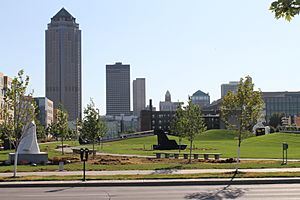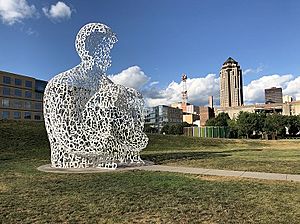Pappajohn Sculpture Park facts for kids
Quick facts for kids Pappajohn Sculpture Park |
|
|---|---|

View of the Pappajohn Sculpture Park
|
|
| Lua error in Module:Location_map at line 420: attempt to index field 'wikibase' (a nil value). | |
| Type | Urban park |
| Location | Des Moines, Iowa, United States |
| Area | 4.4 Acres |
| Created | 2009 |
| Operated by | City of Des Moines and Des Moines Art Center |
| Status | Public |
The Pappajohn Sculpture Park is a cool outdoor art space in Des Moines, Iowa. It's about 4.4 acres big, which is like four football fields! The park opened in 2009. It started with 24 amazing sculptures, and now it has even more. The Des Moines Art Center helps take care of the park. You can see art by famous artists like Louise Bourgeois, Jaume Plensa, and Ai Weiwei here. Many people think it's one of the best outdoor sculpture collections in the whole United States!
Contents
Park History
How the Park Started
The park is named after John and Mary Pappajohn. They are a local couple who love art. They gave the first 24 sculptures to the city of Des Moines. These artworks were worth about $40 million! The Pappajohns are very well-known art collectors. Their art was even in their own yard before the park opened. People used to drive by their house just to see the sculptures!
Designing the Park
Two architects from New York, Diana Agrest and Mario Gandelsonas, designed the park's landscape. They created grassy hills and special curved areas. These curved spaces are like outdoor rooms. They help show off the sculptures in groups that go well together.
Bringing Downtown Back to Life
The Pappajohn Sculpture Park was a big part of making downtown Des Moines new again. In the early 2000s, this part of the city was quite run-down. There were old buildings and empty shops. The city decided to fix this area. They created Western Gateway Park and moved some old buildings. Adding the sculpture park made the area much nicer. It also brought new businesses and investments. When the park opened in 2009, it brought hope. This was especially true after a tough time for the economy and bad floods and tornadoes in Iowa the year before.
New Sculptures and Art Care
Over the years, more sculptures have been added to the park.
- In 2011, White Ghost by Yoshitomo Nara was put in the park. It had been shown in New York before.
- In 2017, the Des Moines Art Center got a special grant. This money helped restore Untitled (Three Dancing Figures, version C) by Keith Haring. The sculpture was strong, but its paint had worn off from being outside for many years.
- In 2018, Pumpkin Large by Japanese artist Yayoi Kusama joined the collection. This bronze pumpkin is about 8 feet tall. It has cool dots all over its surface. The director of the Des Moines Art Center said it's a "very important work" by a top artist.
- In 2019, a version of Robert Indiana's famous LOVE sculpture was placed in the park.
Sculptures to See
List of Artwork
There are currently 28 sculptures in the park. Here are some of them:
- Reclining figure (1982) by Willem de Kooning
- Gymnast III (1985) by William G. Tucker
- Untitled (1985) by Joel Shapiro
- In the morning (1986) by Anthony Caro
- Five plate pentagon (1986) by Richard Serra
- T8 (1987) by Mark Di Suvero
- Juno (1989) and Ancient Forest (2009) by Deborah Butterfield
- Marriage (1989) by Tony Smith
- Order (1989) by Tony Cragg
- Decoy (1990) by Martin Puryear
- Post Balzac (1990) by Judith Shea
- Seating for eight (1990) and Café Table 1 (1992) by Scott Burton
- Untitled (1994) by Ellsworth Kelly
- Thinker on a Rock (1997) by Barry Flanagan
- Spider (1997) by Louise Bourgeois
- LOVE (1999) by Robert Indiana
- Back of a Snowman (black) (2002) and Back of Snowman (white) (2002) by Gary Hume
- Willy (2005) by Tony Smith
- Moonrise.east.january (2005) and Moonrise.east.august (2006) by Ugo Rondinone
- air gets into everything even nothing (2006) by Ugo Rondinone
- Nomade (2007) by Jaume Plensa
- Untitled (Three Dancing Figures, version C) (2009) by Keith Haring
- White Ghost (2010) by Yoshitomo Nara
- Panoramic Awareness pavilion (2013) by Olafur Eliasson
- Iron tree trunk (2015) by Ai Weiwei
- Pumpkin Large (2018) by Yakoi Kusama
Featured Works
Nomade (2007) by Jaume Plensa
One of the most famous sculptures in the park is Nomade by Spanish artist Jaume Plensa. It stands tall over Locust Street. This sculpture was first shown in France in 2007. Later, the Pappajohns bought it for their collection.
The sculpture is a giant human shape, about 27 feet tall. It's made from white steel letters that are connected like a puzzle. You can even walk inside Nomade and look out through the spaces between the letters! This artwork shows Plensa's interest in how people communicate. The letters don't spell real words. Instead, they show the idea of language itself. Many people in Des Moines love Nomade the most.
Images for kids
See also
 In Spanish: Parque de Escultura Pappajohn para niños
In Spanish: Parque de Escultura Pappajohn para niños



